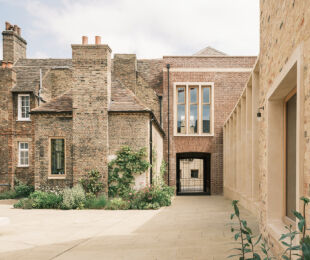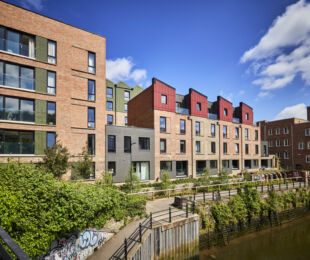
The landmark £24 million Student Halls development for Arts University Bournemouth is home to 300 students and is situated on AUB’s Wallisdown campus. Designed to fit in with the campus’ cutting-edge design aesthetic, the building features eight-bed clusters with communal kitchens and dining areas centred around a landscaped courtyard. This arrangement provides a mix of spaces to create an environment supportive of students.
Clusters provide space for smaller student groups to come together within the garden and adjacent communal spaces support larger group interactions. The high-quality accommodation includes roof-top solar panels, assisting in reducing the building’s energy demand in conjunction with high performance thermal insulation. The development boasts impressive sustainability credentials to benefit both students and local residents. The design includes upgrading the pedestrian and cycle routes that connect nearby areas. Emphasis has been placed on sustainable travel; aside from five accessible spaces, there will be no parking onsite. Ample covered and secure bicycle parking has been integrated into the design, aligning the project with AUB’s travel plan to promote safe and sustainable travel for students and staff.
The use of brick was a central to the original conception of the building's massing, a simple arrangement of brick buildings that enclose a new central courtyard acting to break down the apparent scale of the new accommodation. The halls of residence is an extension of The Arts University Bournemouth's mostly brick Wallisdown campus, pushing their campus boundary to the South. The use of both brick and courtyards act as a reference to the existing campus buildings while evolving its expression in both proportion and detailing.
Where brick is used to express the clusters of student accommodation the communal stair-cores break the massing with a contrasting rain-screen. Communal kitchens and dining areas are marked with a punched bay window looking out into the central landscaped courtyard. This arrangement provides a mix of spaces to create an environment supportive of students. Clusters provide space for smaller student groups to come together within the garden and adjacent communal spaces support larger group interactions. Making and the arts are the life blood of Arts University Bournemouth.
While the new halls creates environments and spaces that foster the students' creativity the skin of the building seeks to express the values of craft and making. Throughout the design process the team tested and explored the use of brick bonds and masonry cill details through digital and physical modelling as well as one to one mock ups. This evolution lead to the development of a 'weave' brick patten created by laying brick courses at a 30 degree angle, reversing the angle of the subsequent course. This pattern-making leads to a dynamic facade treatment, the reading of which changes with light and the angle of the viewer. The clay cill tiles played a key role in unifying material palette and creating a thinner edge that could be achieved in a more typical aluminium cill pressing.
Brick Manufacturer - Michelmersh Brick Holdings PLC
Architect Practice - Design Engine Architects






